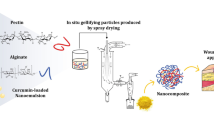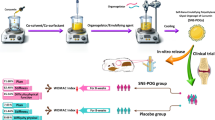Abstract
Purpose
An attempt was made to formulate carvedilol-loaded cubosome (cubogel) to accelerate the wound healing activity. The combined effect of a natural healing agent, Moringa oleifera Lam. leaf extract and cubosomes was also studied.
Methods
Cubosomes were prepared by emulsification method. A 32 factorial design was applied to optimize independent variables: glycerol monooleate and Lutrol F127 and response variables mainly, particle size, entrapment efficiency, and drug release. Optimized formulation was incorporated in the gel base to get cubogel and was characterized for pH, drug content, and viscosity.
Results
Cubosomal formulations were of small particle size (249.2 ± 2.2 nm), exhibited high entrapment efficiency (37.1 ± 1.01%) and effectively delayed drug release (85.02 ± 0.91% within 24 h), hence was selected as optimized formulation. Cubic-shaped cubosomes were confirmed by transmission electron microcopy, having zeta potential − 29.05 mV. Cubosomes were incorporated into Carbopol 934 base (1%) to get cubogel. Texture analyzer demonstrated less spreadability due to viscous nature of cubogel. Diffusion study revealed slow diffusion of drug through the cubosomes. In vivo study was performed in rats using excision wound model; it showed rapid initiation of wound healing on day 3, closing above 94% on day 7 and scar formation on day 10, for both cubogel and cubogel with Moringa oleifera leaf extract.
Conclusion
Carvedilol-loaded cubogel in combination with Moringa oleifera leaf extract can be considered as an excellent formulation to accelerate the wound healing potential.








Similar content being viewed by others
Data Availability
Materials described in the manuscript, including all relevant raw data, will be freely available to any researcher wishing to use them for non-commercial purposes, without breaching participant confidentiality.
References
Abazari M, Ghaffari A, Rashidzadeh H, Badeleh SM, Maleki Y. A systematic review on classification, identification, and healing process of burn wound healing. Int J Low Extrem Wounds. 2022;21(1):18–30.
Guo S, Dipietro LA. Factors affecting wound healing. J Dent Res. 2010;89(3):219–29.
Salazar-Gómez A, Alonso-Castro AJ. Medicinal plants from Latin America with wound healing activity: ethnomedicine, phytochemistry, preclinical and clinical studies-a review. Pharmaceuticals. 2022;15(9):1095.
Mirhaj M, Labbaf S, Tavakoli M, Seifalian AM. Emerging treatment strategies in wound care. Int Wound J. 2022;19(7):1934–54.
Almoshari Y. Development, therapeutic evaluation and theranostic applications of cubosomes on cancers: an updated review. Pharmaceutics. 2022;14(3):600.
Lim DG, Jeong W-W, Kim NA, Lim JY, Lee S-H, Shim WS, et al. Effect of the glyceryl monooleate-based lyotropic phases on skin permeation using in vitro diffusion and skin imaging. Asian J Pharm Sci. 2014;9(6):324–9.
Arafa WM, Elkomy MH, Aboud HM, Ali MI, Abdel Gawad SS, Aboelhadid SM, et al. Tunable polymeric mixed micellar nanoassemblies of Lutrol F127/Gelucire 44/14 for oral delivery of praziquantel: a promising nanovector against hymenolepis nana in experimentally-infected rats. Pharmaceutics. 2022;14(10):2023.
Morsi NM, Abdelbary GA, Ahmed MA. Silver sulfadiazine based cubosome hydrogels for topical treatment of burns: development and in vitro/in vivo characterization. Eur J Pharm Biopharm. 2014;86(2):178–89.
Kwon TK, Hong SK, Kim J-C. In vitro skin permeation of cubosomes containing triclosan. J Ind Eng Chem. 2012;18(1):563–7.
Zakaria F, Ashari SE, Mat Azmi ID, Abdul Rahman MB. Recent advances in encapsulation of drug delivery (active substance) in cubosomes for skin diseases. J Drug Deliv Sci Technol. 2022;68: 103097.
Benkel T, Zimmermann M, Zeiner J, Bravo S, Merten N, Lim VJY, et al. How carvedilol activates β2-adrenoceptors. Nat Commun. 2022;13(1):7109.
Nayak V, Chogtu B, Parimi MRA, Mahapatra AK, Vaishnav RL. Comparison of different adrenergic blockers on cutaneous wound healing in Wistar rats. Br Med Bull. 2014;2(2):371–5.
Al-Ghanayem AA, Alhussaini MS, Asad M, Joseph B. Moringa oleifera leaf extract promotes healing of infected wounds in diabetic rats: evidence of antimicrobial, antioxidant and proliferative properties. Pharmaceuticals. 2022;15(5):528.
Ali A, Garg P, Goyal R, Khan A, Negi P, Li X, et al. An efficient wound healing hydrogel based on a hydroalcoholic extract of Moringa oleifera seeds. S Afr J Bot. 2022;145:192–8.
Lambole V, Kumar U. Effect of Moringa oleifera Lam. on normal and dexamethasone suppressed wound healing. Asian Pac J Trop Biomed. 2012;2(1):S219-S23.
Vongsak B, Sithisarn P, Gritsanapan W. Simultaneous HPLC quantitative analysis of active compounds in leaves of Moringa oleifera Lam. J Chromatogr Sci. 2013;52(7):641–5.
Pandit A, Khandagale K, Nakhate V, Dharmadhikari N. Antifungal topical gel of leaf extract of Amaranthus viridis l. for treatment of cutaneous candidiasis. Indian Drugs. 2019;56(12):39–44.
Gustafsson J, Ljusberg-Wahren H, Almgren M, Larsson K. Submicron particles of reversed lipid phases in water stabilized by a nonionic amphiphilic polymer. Langmuir. 1997;13(26):6964–71.
Hamed R, Seder BY, Bardaweel SK, Qawass H. Lipid-based formulations of microemulsion-loaded oleogels for the oral delivery of carvedilol. J Dispers Sci Technol. 2021:1–11.
Zhang L, Li J, Tian D, Sun L, Wang X, Tian M. Theranostic combinatorial drug-loaded coated cubosomes for enhanced targeting and efficacy against cancer cells. Cell Death Dis. 2020;11(1):1.
Zewail M, PM EG, Ali MM, Abbas H. Lipidic cubic-phase leflunomide nanoparticles (cubosomes) as a potential tool for breast cancer management. Drug Deliv. 2022;29(1):1663–74.
Tang X, Nail SL, Pikal MJ. Evaluation of manometric temperature measurement, a process analytical technology tool for freeze-drying: part I, product temperature measurement. AAPS PharmSciTech. 2006;7:E95–103.
Sanjana A, Ahmed MG, BH JG. Development and evaluation of dexamethasone loaded cubosomes for the treatment of vitiligo. Mater Today: Proc. 2022;50:197–205.
Jelvehgari M, Montazam H. Evaluation of mechanical and rheological properties of metronidazole gel as local delivery system. Arch Pharm Res. 2011;34(6):931–40.
Mahmoud NN, Hikmat S, Ghith DA, Hajeer M, Hamadneh L, Qattan D, et al. Gold nanoparticles loaded into polymeric hydrogel for wound healing in rats: effect of nanoparticles’ shape and surface modification. Int J Pharm. 2019;565:174–86.
Rajoo A, Ramanathan S, Mansor SM, Sasidharan S. Formulation and evaluation of wound healing activity of Elaeis guineensis Jacq leaves in a Staphylococcus aureus infected Sprague Dawley rat model. J Ethnopharmacol. 2021;266: 113414.
Vergara-Jimenez M, Almatrafi MM, Fernandez ML. Bioactive components in Moringa oleifera leaves protect against chronic disease. Antioxidants. 2017;6(4):91.
Karami Z, Hamidi M. Cubosomes: remarkable drug delivery potential. Drug Discov Today. 2016;21(5):789–801.
Barauskas J, Johnsson M, Joabsson F, Tiberg F. Cubic phase nanoparticles (cubosome): principles for controlling size, structure, and stability. Langmuir. 2005;21(6):2569–77.
Bei D, Marszalek J, Youan B-BC. Formulation of dacarbazine-loaded cubosomes—part I: influence of formulation variables. AAPS PharmSciTech. 2009;10:1032–9.
Pan X, Han K, Peng X, Yang Z, Qin L, Zhu C, et al. Nanostructed cubosomes as advanced drug delivery system. Curr Pharm Des. 2013;19(35):6290–7.
Sengottiyan S, Mikolajczyk A, Jagiełło K, Swirog M, Puzyn T. Core, coating, or corona? The importance of considering protein coronas in nano-QSPR modeling of zeta potential. ACS Nano. 2023;17(3):1989–97.
Bessone CDV, Akhlaghi SP, Tártara LI, Quinteros DA, Loh W, Allemandi DA. Latanoprost-loaded phytantriol cubosomes for the treatment of glaucoma. Eur J Pharm Sci. 2021;160: 105748.
Nasr M, Ghorab MK, Abdelazem A. In vitro and in vivo evaluation of cubosomes containing 5-fluorouracil for liver targeting. Acta pharmaceutica sinica B. 2015;5(1):79–88.
Flak DK, Adamski V, Nowaczyk G, Szutkowski K, Synowitz M, Jurga S, et al. AT101-loaded cubosomes as an alternative for improved glioblastoma therapy. Int J Nanomedicine. 2020:7415–31.
Alharbi WS, Hosny KM. Development and optimization of ocular in situ gels loaded with ciprofloxacin cubic liquid crystalline nanoparticles. J Drug Deliv Sci Technol. 2020;57: 101710.
Tarsitano M, Mancuso A, Cristiano MC, Paolino D, Fresta M. In situ swelling formulation of glycerol-monooleate-derived lyotropic liquid crystals proposed for local vaginal application. Molecules. 2022;27(19):6295.
Lai J, Lu Y, Yin Z, Hu F, Wu W. Pharmacokinetics and enhanced oral bioavailability in beagle dogs of cyclosporine A encapsulated in glyceryl monooleate/poloxamer 407 cubic nanoparticles. Int J Nanomedicine. 2010:13–23.
Prajapati V, Jain A, Jain R, Sahu S, Kohli DV. Treatment of cutaneous candidiasis through fluconazole encapsulated cubosomes. Drug Deliv Transl Res. 2014;4:400–8.
Muhammad AA, Pauzi NAS, Arulselvan P, Abas F, Fakurazi S. In vitro wound healing potential and identification of bioactive compounds from Moringa oleifera Lam. Biomed Res Int. 2013;2013.
Muhammad AA, Arulselvan P, Cheah PS, Abas F, Fakurazi S. Evaluation of wound healing properties of bioactive aqueous fraction from Moringa oleifera Lam on experimentally induced diabetic animal model. Drug Des Devel Ther. 2016:1715–30.
Acknowledgements
The authors are grateful to Mylan Labs, India, for providing gift sample of carvedilol phosphate. The authors thank Mohini Organics Pvt. Ltd., Mumbai, India, and BASF, Mumbai, India, for providing gift samples of glycerol monooleate and Lutrol F127, respectively. The authors are grateful to the Sophisticated Instrumentation Centre for Applied Research & Testing, Anand, India, for providing the facility of transmission electron microscopy for the analysis of cubosomes. The authors acknowledge the assistance extended by the Preclinical Research and Development Organization, Private Limited, Pune, India, for providing the facility to run experiments based on animals.
Author information
Authors and Affiliations
Contributions
Conceptualization, Ashlesha Pandit and Vinit Kulkarni; formal analysis, Vaishali Mute and Ujjwala Kandekar; methodology and investigation, Ashlesha Pandit, Vaishali Mute, and Vinit Kulkarni; writing—original draft preparation, Ashlesha Pandit and Ujjwala Kandekar; writing—review and editing, Ashlesha Pandit and Ujjwala Kandekar.
Corresponding author
Ethics declarations
Conflict of Interest
The authors declare no competing interests.
Additional information
Publisher's Note
Springer Nature remains neutral with regard to jurisdictional claims in published maps and institutional affiliations.
Rights and permissions
Springer Nature or its licensor (e.g. a society or other partner) holds exclusive rights to this article under a publishing agreement with the author(s) or other rightsholder(s); author self-archiving of the accepted manuscript version of this article is solely governed by the terms of such publishing agreement and applicable law.
About this article
Cite this article
Pandit, A.P., Kulkarni, V.S., Mute, V.M. et al. Carvedilol-Loaded Cubosome Gel to Accelerate Wound Healing. J Pharm Innov 18, 1926–1940 (2023). https://doi.org/10.1007/s12247-023-09766-x
Accepted:
Published:
Issue Date:
DOI: https://doi.org/10.1007/s12247-023-09766-x




